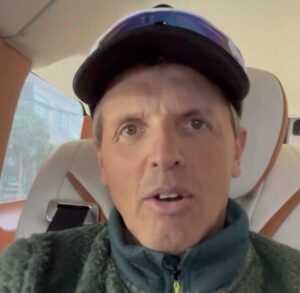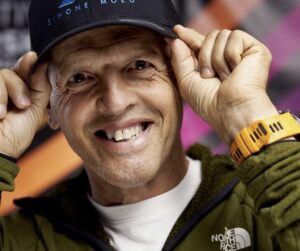A guide on Everest (he has topped out nine times) and a summer K2 summiter, Noel Hanna of Northern Ireland hardly fits the “tourist” tag of some members of Seven Summit Trek’s recent expedition to K2. Neither is he prone to tell epic stories of chaos and near-death experiences. When ExplorersWeb asked Hanna if the expedition turned out as he had expected, he firmly answered, “Yes, it has.”
“I knew that K2 had never been summited in winter before so it was going to be a bonus if we did it,” he said.
Not that he was there just to get by. He really wanted to reach the summit, “if the weather allowed it — but it didn’t,” Hanna said. “You need a three-day weather window for a summit push and that is unusual in winter.”
Notably, Hanna disagrees with the general perception of inexperienced tourists flocking to an impossible and potentially deadly venture.
“Some people think that Seven Summit Treks had just gathered people to get the money, but I think was clear from the start that no one should attempt something like winter K2 without wide previous experience,” he said. “Ninety percent of the people had been on at least six 8,000’ers before.
“Besides, when we launched our summit push, some climbers turned around at Camp 1, which I think was good because they honestly assessed their own abilities.
“To me, that window was not good enough for anybody to attempt the summit. It was very different for the Nepali team two weeks before. They did have a three-day window and were set up at Camp 3, so they didn’t need to go all the way from BC for the summit attack.”
Although the tragic end of the expedition left a bitter taste to the entire venture, everything went well during the first weeks.
“Overall, the atmosphere was good,” said Hanna. “Everybody was happy. When the Nepalis summited, the mood got even better, because they had proved that it was possible to reach the summit, and weather permitting, we might get there too.
“But we were not lucky enough to enjoy such a long window. Moreover, after two weeks of hanging around Base Camp, we were starting to lose our acclimatization. Then with such small break in the weather, the odds were against.”
Summit Push against all odds
Still, he tried. “Yes, I did, of course, hoping the window might end up being a bit longer. I was receiving my own fresh forecasts from home every day. But before I left C2 [on the morning of February 4], my wife told me that according to the hourly data from the summit of K2, the winds were higher than expected. So in the back of my mind, I was already considering the idea of turning around unless conditions changed — and they didn’t. That is why I didn’t even try to get above Camp 3.”
The situation at Camp 3 wasn’t ideal, Hanna says, but neither was it as chaotic as reported.

Noel Hanna (yellow and black) waves in Camp 3. Antonios Sykaris, in blue and yellow, crouches in front. Photo: Noel Hanna
“I reached Camp 3 at 5, 5:30 pm, and it was already dark,” recalls Hanna. “Tomaz, Colin, Pablo, possibly Ali were already there, and Tamara had just arrived in front of me. I knew my Sherpa was right behind me, so when I arrived, I went to check on Tamara and Pablo, chatted for 15 to 20 minutes, and then Tempa said, “Hey Noel, the tent’s ready!”
As for other tents, or lack of them: “Three tents were supposed to be there, deposited — as I understand it — by the Sherpa team which had summited two weeks before. They had left these tents in C3 in order to avoid taking them down and also knowing that other climbers would be coming up later. When I reached the camp, there was Pablo (Juan Pablo Mohr) and Tamara Lunger’s tent, Colin O’Brady and his Sherpas with Tomaz Rotar in another tent, and — it was dark, but there might have been another tent. While I was talking to Pablo, the Sherpas put up one more tent, but I am not sure if they found it or if they had carried it with them.
“I entered a tent, and there was me, Santa Claus (that’s Bernhard Lippert, we called him Santa because of his long beard), two Sherpas, and then Antonio [Sykaris] came in.”
Sykaris had mentioned that it was Noel who let him in after he begged for a place in a tent for nearly an hour. However, Hanna explained: “It’s not me letting him in, because it wasn’t my tent, it was the expedition’s tent. I do remember, that’s true, Antonio coming and me telling him to get in.”
“Nobody was left outside, everybody got into a tent. To me, it wasn’t that bad. At very high altitude, it’s just like on Everest: You don’t put up a tent for one or two people. At altitude, it’s so difficult to put up a tent that the norm is to have three, four, five people sharing each tent, rather than getting frostbitten trying to pitch more tents. So well, yes, it would have been nicer to have one less in the tent, but it really didn’t bother me.”
“On the morning of February 5, I was completely sure that I was going down. Winds were expected to pick up to 50 to 60kph that afternoon and then increase to over 100kph on the summit, so descending was a no-brainer.” In the video below, from Camp 3, Hanna explains his final decision:
The descent was uneventful, Hanna recalls. “I went down with Tamara, stopping every 30 to 40 minutes. It took long, especially 15 minutes below Camp 1 when Tamara’s headlamp fell off and we had to progress with only my lamp. It started to run low on batteries by ABC. We finally had to use the light of Tamara’s iPhone. But otherwise, we were okay, and it was a beautiful, starry night.”
Hanna can’t figure out how those who stayed behind to go for the summit crossed the great crevasse that Tomaz Rotar spoke about. “I had no idea of the existence of that obstacle until I read a FaceBook post a couple of days ago,” he said. “When we went to Camp 3, no one knew there will be an impassable crevasse because the Nepalis had taken an alternative route. I did know that there is a crevasse near Camp 4 because it was there when I climbed K2 in 2018, but I never thought it would be a problem because the Nepalis had gone up to the summit before, right? Also, it seems that Ali, John, and JP managed somehow to cross that crevasse, somewhere…”
Commercial but not guided
There has been debate about the instructions that climbers supposedly received before launching the summit push — if you don’t get so far by such-and-such a time, you must turn back — and whether some of them didn’t pay attention. For Hanna, it was an individual decision based on an honest assessment of conditions and a person’s capabilities.
“To me, it was clear that we signed up for a commercial but non-guided expedition. It was known that everyone should be working independently and making their own decisions. SST gave you forecasts (I had my own, in addition, from home) and that sort of thing, but there is no way that you could get a guided expedition on a winter 8,000’er, least of all on K2. To me, if you sign up for a non-guided expedition, you can’t expect to be guided.
“During our summit push, everybody was going slower than on previous rotations, including Ali and John. I don’t know whether that was due to cold or because we had lost some of our acclimatization, but the fact is, we were all slow. Eventually, some climbers turned around…when they felt it was right.
“To me, everyone should know their own limitations, they should not expect anyone else to tell them when their time is up. Times between camps may be used as a reference, but it’s only logical that if you intend to embark on a 15-hour summit push from Camp 3, you should reach that Camp by 2 pm in order to rest before leaving.
“But when people started reaching C3 at 5, 6, 6:30 pm, and the following stages were delayed too, the decision was obvious. The wind was not going to stay weak for four more hours just because you reached Camp 3 more slowly.
“Some people think that the Sherpas were going to get them to the summit and back, but they are not different from anyone else about getting cold and frostbitten. Some Sherpas had problems trying to get to Camp 3. As I said to Antonios when his Sherpa decided to turn around, if they lose fingers and toes, they are finished, because they won’t be able to work! They’re just human and they must take care of themselves first of all. If the Sherpas continue because their client wants to reach a summit and they get frostbite, then what? The client will go home and not take care of them anymore.
“Some people were really busy with Instagram throughout the expedition and that can be a problem: They are under so much pressure to try and reach the summit, despite conditions and skills. In my opinion, if people had made it to Camp 3 one to two hours earlier and more climbers had headed up on the morning of February 5, there may have been more than three missing climbers by the end of the day.”
Hanna does not have much time for the debate around the Nepali summit and the subsequent lack of information. He thinks they might just be following sponsors’ requirements. He spoke to Sona and Gelje Sherpa back in BC after their summit but recalls no details being shared. “They do not speak that much English,” he points out. “Nothing was discussed when the team returned, and they didn’t remain in BC for long. They came by for my birthday and left the following morning.”
Hanna wonders about all the speculation and questions among the climbing community: “Could it be just jealousy because the Sherpas were the first to summit K2 in winter?”
Future plans
Would Hanna try another winter 8,000’er in the future?
“Yes, if the right team and the right people were going. Maybe Everest, where it is easier to get back down the valley. Also, next month I am going to Everest for what I expect to be my 10th summit, and I’ve always said I would like to try once without O2. Then why not try one more time in winter to make it a dozen?”
As for guided winter expeditions, he does not see something like that catching on in the next few years, although eventually, perhaps, it could be tried “on some of the easier peaks, like Manaslu.”
Manaslu was attempted this winter without success, but according to Hanna, the reason was the huge amount of work required for that small team. “If you have 8 or 10 Sherpas fixing the route, it’s a different story. That was the reason I joined K2, in fact. If it had been a three-person team, I would not have even considered going.”
Hanna has also offered to return to K2 this summer, not for the summit, but to help Sajid Sadpara find the bodies of his father and John Snorri and Juan Pablo Mohr.
“I’ve mentioned to Ali’s friends and Pakistan Climbing Association that I would volunteer if they need experienced climbers to help. But I am not sure how it will be organized, since they said that the local government and the army could be involved.”






